Christmas decoration
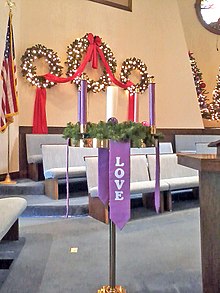

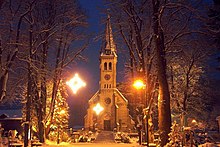
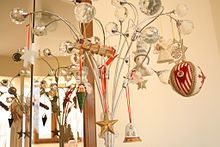
A Christmas decoration is any of several types of ornamentation used at Christmas and the greater Christmas and holiday season. The traditional colors of Christmas are pine green (evergreen), snow white, and heart red. Gold and silver are also prevalent, as are other metallic colours. Typical images on Christmas decorations include Baby Jesus, Mother Mary, angels, Father Christmas, Santa Claus, and the star of Bethlehem. Advent wreaths, nativity scenes, illuminations, and Moravian stars are popular Christmas decorations.[1]
In many countries, such as Sweden, people start to set up their Advent and Christmas decorations on the first day of Advent.[2] Liturgically, this is done in some parishes through a Hanging of the Greens ceremony.[3] In the Western Christian world, the two traditional days when Christmas decorations are removed are Twelfth Night and if they are not taken down on that day, Candlemas, the latter of which ends the Christmas-Epiphany season in some denominations.[4] Taking down Christmas decorations before Twelfth Night, as well as leaving the decorations up beyond Candlemas, is historically considered to be inauspicious.[5][6]
The traditional colors of Christmas decorations are red, green, and gold.[7][8] Red symbolizes the blood of Jesus, which was shed in his crucifixion; green symbolizes eternal life, and in particular the evergreen tree, which does not lose its leaves in the winter; and gold is the first color associated with Christmas, as one of the three gifts of the Magi, symbolizing royalty.[9]
History
[edit]Christmas decorations are mentioned in ancient descriptions of the Roman feast Saturnalia, which was believed to have originated in the 5th century BC.
The tradition of decorating a tree is old since the Celts already decorated a tree, the symbol of life at the time of the winter solstice.[10] The Scandinavians did the same for the Yule festival, which was held around the same date as Christmas.
Tertullian complained to the 2nd century that Christians in North Africa decorated their homes with greenery, a pagan symbol.[11]
Tree
[edit]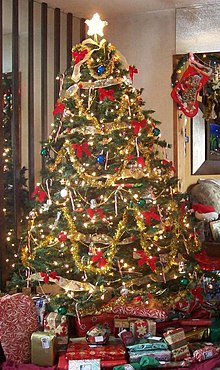
The Christmas tree was first used by German Lutherans in the 16th century, with records indicating that a Christmas tree was placed in the Cathedral of Strassburg in 1539, under the leadership of the Protestant Reformer, Martin Bucer.[12][13] In the United States, these "German Lutherans brought the decorated Christmas tree with them; the Moravians put lighted candles on those trees."[14][15] When decorating the Christmas tree, many individuals place a star at the top of the tree symbolizing the Star of Bethlehem, a fact recorded by The School Journal in 1897.[16][17] Professor David Albert Jones of Oxford University writes that in the 19th century, it became popular for people also to use an angel to top the Christmas tree to symbolize the angels mentioned in the accounts of the Nativity of Jesus.[18] In discussions of folklore, some claim that the Christmas tree is a Christianization of pagan tradition and ritual surrounding the winter solstice, which included the use of evergreen boughs, and an adaptation of pagan tree worship;[19] according to eighth-century biographer Æddi Stephanus, Saint Boniface (634–709), who was a missionary in Germany, took an axe to an oak tree dedicated to Thor and pointed out a fir tree, which he stated was a more fitting object of reverence because it pointed to heaven; it had a triangular shape, which he said was symbolic of the Trinity.[20] However, the English-language phrase "Christmas tree" is first recorded in 1835[21] and represents an importation from the German language.[22] From Germany the custom was introduced to England via two German-born royal consorts, Queen Charlotte and Prince Albert. The influential 1840s image of Queen Victoria's decorated evergreen was republished in the United States. As the first widely circulated picture of a decorated Christmas tree in America, the custom there spread.[23] Christmas trees may be decorated with lights and ornaments. Mount Ingino Christmas Tree in Gubbio in Italy is the tallest Christmas tree in the world.[24]
Types of decorations
[edit]Glass ornaments
[edit]Figural glass Christmas ornaments originated in the small town of Lauscha, Germany in the latter half of the 19th century.[25] The town had long produced fine glassware. The production of Christmas ornaments became a family affair for many people. Some families invested 16 hours a day in production. For some, it was their sole source of income.
Sometimes, competitions were held. Prizes were awarded to the family, producing the finest examples. Santa Clauses, angels, birds, animals, and other traditional Yuletide subjects were favorites.
F.W. Woolworth discovered these glass ornaments on a toy and doll-buying trip to Sonnenburg, Germany, in the 1890s. He sold them in his "five and ten cent" stores in America. The ornaments were said to have contributed to Woolworth's business success.[26]
For the American market, figures depicting comic book characters and patriotic subjects such as Uncle Sams, eagles, and flags were blown. Glassblowers have held on to the old molds. Glass ornaments are still created from these old molds.
Method
[edit]A clear glass tube is heated over an open flame. It is then inserted into a mold. The glassblower then blows into the end of the tube. The glass expands to fill the mold. The glass takes on the shape of the mold. It is cooled. A silver nitrate solution is swirled about inside the ornament. This gives the ornament a silver glow. The outside of the ornament is painted or decorated with metal trims, paper clippings, etc.[25]
Cotton batting
[edit]Cotton batting Christmas ornaments were popular during the German Christmas toy and decoration boom at the turn of the century. They were exported in large numbers to the United States. These decorations suggested puffs of snow. Fruits and vegetables were popular subjects and often had a realistic appearance. African-American and patriotic characters were fashioned for the American market. Some ornaments were used to hide boxes of candy.
Assembling these decorations was a cottage industry. Cotton batting was wound around a wire frame resembling a human or animal. A face was painted, or a lithograph cut-out was affixed to the batting. Figures were given crepe paper costumes. Some were touched with glue and sprinkled with mica flakes for a glittering appearance.[27]
Dresden
[edit]Dresdens are three-dimensional ornaments. They are made of paper, card, or cardboard. Dresdens were produced mostly in Dresden and Leipzig, Germany, from the 1860s to WWI. They were originally priced between 1 and 60 cents. Subjects included animals and birds, suns and moons, humans, carriages and ships, etc. Some Dresdens were flat, allowing the buyer to collect them in scrapbooks.
Positive and negative molds were set into a press. A moistened sheet of card was put into the press. The images were pressed. When they had dried, they were sent to cottage workers for the finishing touches. This involved separating the form-halves from the card, trimming ragged edges, and gluing the two halves together. The form was then gilded, silvered, or hand-painted. Sometimes, a small gift or sweet was put into the form. Forms were usually no larger than five inches.[28][29]
Nativity scenes
[edit]
Nativity scenes are known from 10th-century Rome. The first living nativity scene, attributed to Saint Francis of Assisi, occurred in 1223 in the Italian town of Greccio, quickly spreading across Europe.[30] Different types of decorations developed across the Christian world, dependent on local tradition and available resources, and can vary from simple representations of the crib to far more elaborate sets – renowned manger scene traditions include the colourful Kraków szopka in Poland,[31] which imitate Kraków's historical buildings as settings, the elaborate Italian presepi (Neapolitan [it], Genoese [it] and Bolognese [it]),[32][33][34][35] or the Provençal crèches in southern France, using hand-painted terracotta figurines called santons.[36] In Malta, light-deprived vetches (ġulbiena) are placed next to the statue of the baby Jesus in the manger and static nativity scenes adorning houses and churches.[37] [38][39][40]
In certain parts of the world, notably Sicily, living nativity scenes following the tradition of Saint Francis are a popular alternative to static crèches.[41][42][43] The first commercially produced decorations appeared in Germany in the 1860s, inspired by paper chains made by children.[44] In countries where a representation of the Nativity scene is very popular, people are encouraged to compete and create the most original or realistic ones. Within some families, the pieces used to make the representation are considered a valuable family heirloom.[45]
Plants
[edit]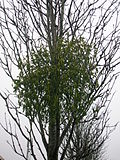
Popular Christmas plants include holly, mistletoe, ivy and Christmas trees. The interior of a home may be decorated with these plants, along with garlands and evergreen foliage. These often come with small ornaments tied to the delicate branches and sometimes with a small light set.

Wreaths are made from real or artificial conifer branches, or sometimes other broadleaf evergreens or holly. Several types of evergreen or even deciduous branches may be used in the same wreath, along with pinecones and sprays of berries, and Christmas ornaments including jingle bells. A bow is usually used at the top or bottom, and an electric or unlit candle may be placed in the middle. Christmas lights are often used, and they may be hung from doors or windows, and sometimes walls, lampposts, light fixtures, or even statuary.
Since the nineteenth century, the poinsettia, a native plant from Mexico, has been associated with Christmas
Different places also have different traditions and superstitions about when and how to remove Christmas decorations.[46] For example, in some parts of England, people believed that if Christmas greenery were thrown away instead of being burned, a ghost would appear, but in other parts, they believed that if the greenery were burned instead of being thrown away, a family member would die.[46]
Outdoors
[edit]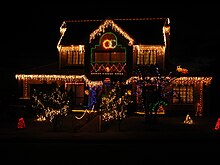
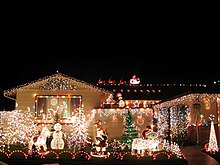
In North and South America, Australia, and Europe, it is traditional to decorate the outside of houses with lights and sometimes with illuminated sleighs, snowmen, and other Christmas figures. Municipalities often sponsor decorations as well. Christmas banners may be hung from street lights and Christmas trees placed in the town square.[47]
Others
[edit]In the Western world, rolls of brightly colored paper with secular or religious Christmas/winter/Hanukkah motifs are manufactured for giftwrapping presents. The display of Christmas villages has also become a tradition in many homes this season. Other traditional decorations include bells, reindeer, candles, candy canes, garland, stockings, wreaths, snow globes, and angels. Snow sheets are made specifically for simulating snow under a tree or village.
In many countries, a representation of the Nativity scene is prevalent, and people are encouraged to compete and create the most original or realistic ones. Within some families, the pieces used to make the representation are considered a valuable family heirloom. Some churches also perform a live Nativity with volunteers and even live animals.
Among the most popular items of Christmas decorations are stockings. According to legend, Saint Nicolas would creep in through the chimney and slip gold into stockings hanging by the fireplace. Various forms of stockings are available, from simple velvet ones to sock-shaped bags to animated ones.
Season
[edit]
Christmas decorations are typically put up in late November or early December, usually to coincide with the start of Advent. In the UK, Christmas lights on the high street are generally switched on in November.[48] In the US, the traditional start of the holiday season is Thanksgiving.[citation needed] Major retailers put their seasonal decorations out for sale after back-to-school sales, while smaller niche Christmas Stores sell Christmas decorations year round.[citation needed]

In some places, Christmas decorations are traditionally taken down on Twelfth Night, the evening of January 5 or January 6. The difference in this date is that some count Christmas Day as the first day of Christmas, whereas for others, Christmas Day is a feast day in its own right, and the first full day of the Christmas Season is December 26. In Hispanic and other cultures, this is more like Christmas Eve, as the Three Wise Men bring gifts that night. Therefore, decorations are left up longer.[citation needed] The same is true[citation needed] in Eastern Churches which often observe Christmas according to the Julian Calendar, thus making it fall 13 days later.
In England, it was customary to burn the decorations in the hearth. However, this tradition has fallen out of favour as reusable and imperishable decorations made of plastics, wood, glass and metal became more popular. If a Yule log has been kept alight since Christmas Day, it is put out, and the ashes are kept to be included in the fire on the following Christmas Day.[49] A superstition exists which suggests that if decorations are kept up after Twelfth Night, they must be kept up until the following Twelfth Night, but also that if the decorations for the current Christmas are taken down before the New Year begins, bad luck shall befall the house for a whole year.[citation needed]
In the United States, many stores immediately remove decorations the day after Christmas, as some think of the holiday season as being over once Christmas has passed.[citation needed] A vast majority of Americans who put up home decorations keep them out and lit until at least New Year's Day, and inside decorations can often be seen in windows for several weeks afterward.
- Christmas ornaments hanging on a Christmas Tree
- Christmas decorations at the Indooroopilly Shopping Centre, Australia, 2020
References
[edit]- ^ "The Putz and Illumination". Moravian Church. November 19, 2018. Retrieved December 3, 2023.
- ^ Michelin (October 10, 2012). Germany Green Guide Michelin 2012–2013. Michelin. p. 73. ISBN 9782067182110.
Advent – The four weeks before Christmas are celebrated by counting down the days with an advent calendar, hanging up Christmas decorations and lightning an additional candle every Sunday on the four-candle advent wreath.
- ^ Rice, Howard L.; Huffstutler, James C. (January 1, 2001). Reformed Worship. Westminster John Knox Press. p. 197. ISBN 978-0-664-50147-1.
Another popular activity is the "Hanging of the Greens," a service in which the sanctuary is decorated for Christmas.
- ^ "Candlemas". British Broadcasting Corporation. Retrieved April 9, 2014.
Any Christmas decorations not taken down by Twelfth Night (January 5th) should be left up until Candlemas Day and then taken down.
- ^ Raedisch, Linda (October 1, 2013). The Old Magic of Christmas: Yuletide Traditions for the Darkest Days of the Year. Llewellyn Publications. p. 161. ISBN 978-0-7387-3450-7. Retrieved April 9, 2014.
- ^ McGregor, Kate (November 30, 2023). "It's Bad Luck To Take Your Tree Down Before January 6". AOL.
According to the tradition of the 12 days of Christmas (explained above), January 6 is the earliest you should be taking down your Christmas tree. According to the legend, bad luck will befall those who stop the Christmas cheer any earlier.
- ^ Andersen, Charlotte Hilton (October 11, 2021). "Why Are the Christmas Colors Red and Green?". Reader's Digest. Retrieved December 22, 2024.
- ^ "Here's the History Behind Why Red and Green Are the Traditional Christmas Colors". Country Living. October 29, 2019. Retrieved December 22, 2024.
- ^ Collins, Ace (2003). Stories Behind the Great Traditions of Christmas. Grand Rapids: Zondervan. ISBN 978-0-310-87388-4.
- ^ / FR / cadre_repertoire / social / Reflexion / Noel / noel_origines.html The millennial cult of the sun
- ^ Cafe-discoveries / Sons / Le-Pere-Noel-est-il-une-junk-350601 / Is Santa Claus a junk? Archived June 1, 2013, at the Wayback Machine Broadcast from Europe 1, December 24, 2010
- ^ Senn, Frank C. (2012). Introduction to Christian Liturgy. Fortress Press. p. 118. ISBN 9781451424331.
The Christmas tree as we know it seemed to emerge in Lutheran lands in Germany in the sixteenth century. Although no specific city or town has been identified as the first to have a Christmas tree, records for the Cathedral of Strassburg indicate that a Christmas tree was set up in that church in 1539 during Martin Bucer's superintendency.
- ^ "The Christmas Tree". Lutheran Spokesman. 29–32. 1936.
The Christmas tree became a widespread custom among German Lutherans by the eighteenth century.
- ^ Kelly, Joseph F. (2010). The Feast of Christmas. Liturgical Press. p. 94. ISBN 9780814639320.
German Lutherans brought the decorated Christmas tree with them; the Moravians put lighted candles on those trees.
- ^ Blainey, Geoffrey (October 24, 2013). A Short History of Christianity. Rowman & Littlefield Publishers. p. 418. ISBN 9781442225909.
Many Lutherans continued to set up a small fir tree as their Christmas tree, and it must have been a seasonal sight in Bach's Leipzig at a time when it was virtually unknown in England, and little known in those farmlands of North America where Lutheran immigrants congregated.
- ^ Mandryk, DeeAnn (October 25, 2005). Canadian Christmas Traditions. James Lorimer & Company. p. 67. ISBN 9781554390984.
The eight-pointed star became a popular manufactured Christmas ornament around the 1840s and many people place a star on the top of their Christmas tree to represent the Star of Bethlehem.
- ^ Wells, Dorothy (1897). "Christmas in Other Lands". The School Journal. 55. E.L. Kellogg & Company: 697–8.
Christmas is the occasional of family reunions. Grandmother always has the place of honor. As the time approaches for enjoying the tree, she gathers her grandchildren about her, to tell them the story of the Christ child, with the meaning of the Christ child, with the meaning of the Christmas tree; how the evergreen is meant to represent the life everlasting, the candle lights to recall the light of the world, and the star at the top of the tree is to remind them of the star of Bethlehem.
- ^ Jones, David Albert (October 27, 2011). Angels. Oxford University Press. p. 24. ISBN 9780191614910.
The same ambiguity is seen in that most familiar of angels, the angel on top of the Christmas tree. This decoration, popularized in the nineteenth century, recalls the place of the angels in the Christmas story (Luke 2.9–18).
- ^ van Renterghem, Tony. When Santa was a shaman. St. Paul: Llewellyn Publications, 1995. ISBN 1-56718-765-X
- ^ Fritz Allhoff, Scott C. Lowe (2010). Christmas. John Wiley & Sons.
His biographer, Eddius Stephanus, relates that while Boniface was serving as a missionary near Geismar, Germany, he had enough of the locals' reverence for the old gods. Taking an axe to an oak tree dedicated to Norse god Thor, Boniface chopped the tree down and dared Thor to zap him for it. When nothing happened, Boniface pointed out a young fir tree amid the roots of the oak and explained how this tree was a more fitting object of reverence as it pointed towards the Christian heaven and its triangular shape was reminiscent of the Christian trinity.
- ^ Harper, Douglas, Christ, Online Etymology Dictionary, 2001.
- ^ "The Chronological History of the Christmas Tree". The Christmas Archives. Archived from the original on December 21, 2007. Retrieved December 18, 2007.
- ^ Shoemaker, Alfred Lewis. (1959) Christmas in Pennsylvania: a folk-cultural study. Edition 40. p.52,53. Stackpole Books 1999. ISBN 0-8117-0328-2
- ^ "Celebrate Christmas Italian Styles at These City Events". TripSavvy. Retrieved January 26, 2021.
- ^ a b Merck (1992), p. 43
- ^ Merck (1992), p. 41
- ^ Merck (1992), pp. 65-69
- ^ Merck (1992), pp. 54–63
- ^ Smith and Smith (1993), p. 56
- ^ Collins, Ace; Hansen, Clint (2003). Stories behind the great traditions of Christmas. Grand Rapids, Mich: Zondervan. p. 47. ISBN 978-0-310-24880-4.
- ^ Weber, Susan Topp (2013). Nativities of the world. Internet Archive. Layton, Utah : Gibbs Smith. ISBN 978-1-4619-5398-2.
- ^ "Alla scoperta dei cinque presepi più belli di Bologna | Nuok". December 27, 2013. Archived from the original on December 27, 2013. Retrieved December 22, 2024.
- ^ ""Presepi in Liguria: provincia di Genova, Tigullio -sito di Paolino". Digilander.libero.it". Archived from the original on December 27, 2013. Retrieved December 22, 2024.
- ^ "Holidays at the Museums : Carnegie Museum of Natural History". December 27, 2013. Archived from the original on December 27, 2013. Retrieved December 22, 2024.
- ^ Bershad, David; Mangone, Carolina; Hexham, Irving (December 25, 2022). The Christian Travelers Guide to Italy - David Bershad, Carolina Mangone, Irving Hexham - Google Books. Harper Collins. ISBN 978-0-310-22573-7. Retrieved December 22, 2024.
- ^ "The Provençal Nativity Scene". archive.ph. September 14, 2012. Retrieved December 22, 2024.
- ^ "Do you have Green Fingers? - Esplora". Esplora - Esplora Interactive Science Center. December 6, 2020. Retrieved December 22, 2024.
- ^ "Focus: Remembering The Birth of Jesus - The Malta Independent". www.independent.com.mt. Retrieved December 22, 2024.
- ^ "Museum of the Bible to host special delegation from Malta for second annual 'Christmas in Malta' crib exhibition". Museum of the Bible. Retrieved December 22, 2024.
- ^ "Where did gulbiena come from? The story behind Malta's curious Christmas tradition". www.guidememalta.com. December 19, 2015. Retrieved December 22, 2024.
- ^ Seaburg, Carl (December 25, 2022). Celebrating Christmas: An Anthology - Carl Seaburg - Google Books. iUniverse. ISBN 978-0-595-30974-0. Retrieved December 22, 2024.
- ^ Bowler, Gerry (December 25, 2022). The World Encyclopedia of Christmas - Gerry Bowler - Google Books. McClelland & Stewart. ISBN 978-1-55199-607-3. Retrieved December 22, 2024.
- ^ "A Christmas Living Nativity Scene In Sicily | Italy Magazine". December 26, 2013. Archived from the original on December 26, 2013. Retrieved December 22, 2024.
- ^ Collins, Ace (2003). Stories Behind the Great Traditions of Christmas. Grand Rapids: Zondervan. p. 83. ISBN 978-0-310-87388-4.
- ^ Joesten, Joachim (1947). "The Strange Ways of German Democracy". The Antioch Review. 7 (1): 17–22. doi:10.2307/4609187. ISSN 0003-5769. JSTOR 4609187.
- ^ a b "Good luck or bad? How Christmas decorating traditions vary in England". the Guardian. December 2, 2022. Retrieved January 5, 2023.
- ^ Murray, Brian. "Christmas lights and community building in America," Archived October 26, 2006, at the Wayback Machine History Matters, Spring 2006.
- ^ BBC – London's Oxford Street and Regent Street Christmas lights have been switched on at precisely the same time.
- ^ Twelfth Night Traditions Archived September 5, 2015, at the Wayback Machine


 French
French Deutsch
Deutsch

